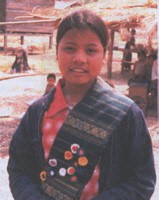Lao Krang in Thailand

Photo Source:
Copyrighted © 2026
Peoples of the Buddhist World, Asia Harvest All rights reserved. Used with permission |
Send Joshua Project a map of this people group.
|
| People Name: | Lao Krang |
| Country: | Thailand |
| 10/40 Window: | Yes |
| Population: | 59,000 |
| World Population: | 59,000 |
| Primary Language: | Language unknown |
| Primary Religion: | Buddhism |
| Christian Adherents: | 0.06 % |
| Evangelicals: | 0.05 % |
| Scripture: | Unspecified |
| Ministry Resources: | No |
| Jesus Film: | No |
| Audio Recordings: | No |
| People Cluster: | Lao |
| Affinity Bloc: | Southeast Asian Peoples |
| Progress Level: |
|
Introduction / History
The Lao Krang language is closely related to the Lao language of Laos and Isan of north-east Thailand. This linguistic link results from the history of the Lao Krang. They originally lived in the eastern part of Luang Prabang Province in Laos and parts of the neighboring Houaphan Province.
When the Siamese army invaded Laos in the 1770s, they captured the forefathers of the Lao Krang and took them as prisoners of war far across Thailand to their present locations. The Thai authorities first used the Lao Krang as laborers, to increase food production to feed the Siamese military. For several generations the Lao Krang were forced to work for their captors, until they were granted freedom by the great King Chulalongkorn in the early 1900s.
The Lao Krang of Thailand are not the same people group as the Lao Khang of Laos. The Lao Krang derive their name from their skills in extracting a type of organic paste from the krang beetle, which they use to make a bright red dye for their textiles. These days, however, only the Lao Krang in western Thailand continue this custom, as the krang beetle is not found in central Thailand. There they use commercial chemical dyes. The traditional dress of Lao Krang women is striking, with vivid orange, red and yellow colors decorating their clothing.
Lao Krang people inhabit a large area of central and western Thailand. Their communities spill into at least eight provinces, including Phichit, Suphan Buri, Uthai Thani, Chai Nat, Phitsanulok, Kamphaeng Phet, Nakhon Pathom and Nakhon Sawan.
What Are Their Lives Like?
The regions inhabited by the Lao Krang are well-watered and ideal for agricultural production. Their main crops are rice, maize and peanuts, which they produce in commercial quantities. They also raise chickens, ducks, pigs, and buffaloes. Many Lao Krang youth have turned away from making their living through farming and have found jobs in the cities and large towns in the region, and also in Bangkok.
Until fifteen or twenty years ago, the Lao Krang married only within their own tribe. A bride price was set depending on the social class of the bride and groom. Wealthy families had to pay a traditional bride price. These days many Lao Krang youth are intermarrying with the Thai, Isan and other ethnic groups.
What Are Their Beliefs?
The Lao Krang are strong and zealous Theravada Buddhists. Until recent decades, every young Lao Krang man had to enter the monkhood to become a novice before they could marry. In Lao Krang society, Buddhist teachings are the roots for social harmony and an emotionally and physically stable environment.
Besides their belief in Buddhism, the Lao Krang honor a multitude of spirits and worship their ancestors. They believe in good and bad spirits who inhabit the house, village, forest, water, trees, etc. The most important of these spirits is the guardian of the village, called hoo jau nei.
What Are Their Needs?
Like all other peoples of the world, this people group needs the blessings and guidance that only Jesus Christ can offer.
Prayer Points
Pray for the Lord to provide them with an abundant harvest as a testimony of his power and goodness.
Ask God to raise up Lao Krang who are more desirous to know the truth than to stay on the broad road.
Ask God to send loving, committed workers to the Lao Krang in the near future.
Pray the Lao Krang would no longer be hidden away from the influence of Christ.